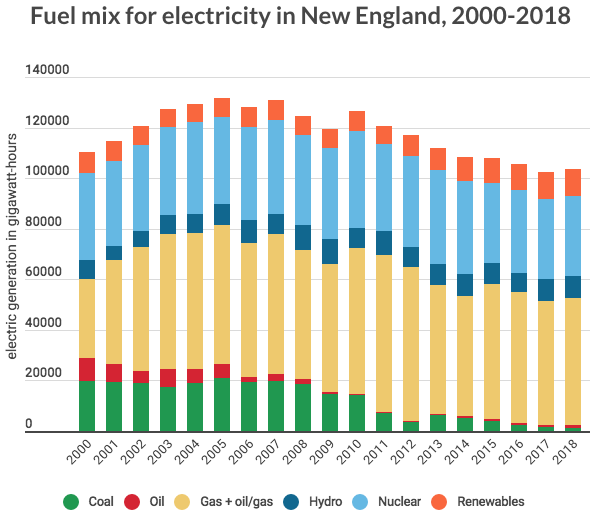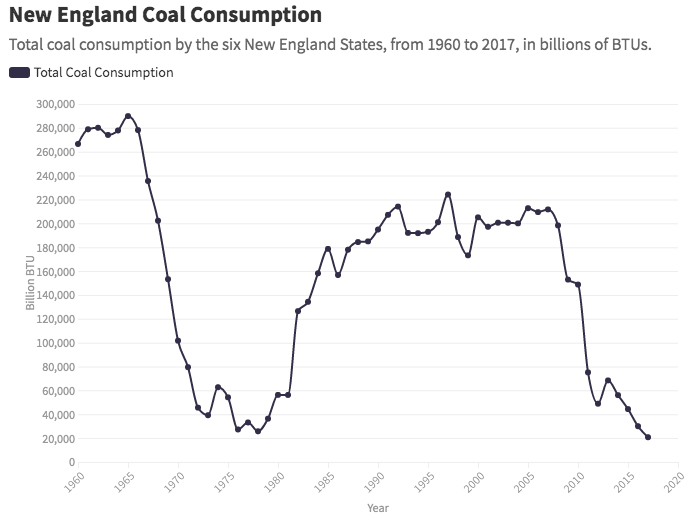The U.S. Northeast is phasing out its coal-fired power plants. Both New England and New York generated 15 percent of their electricity from coal in 2007 when coal-fired generation was at its peak in the United States, and now both areas are generating less than one percent of their power from coal. New York is performing its phase-out of coal plants using regulation, while New England is expecting the phase-out to happen due to market forces.
New England
In 2019, New England generated 49 percent of its electricity from natural gas, 31 percent from nuclear power, 9 percent from hydroelectric power, and 11 percent from renewable energy, including wind, wood, and solar power. Coal supplied just 0.5 percent and oil just 0.2 percent of the region’s generation. There are only three coal-fired power plants in New England: The Merrimack and Schiller Stations in New Hampshire and the Bridgeport Station in Connecticut that is being replaced by a nearby natural gas-fired plant and scheduled to be retired next yea. Coal is generally used in New England only during peak demand periods to avoid electricity price spikes or power shortages when demand is high on very cold winter days and very hot summer afternoons.

Power plants in New England get paid for producing electricity and by being ready and available to produce electricity whenever demand spikes. The “forward capacity market” in the region allows power plants to bid to be “on call.” As a result, they must participate each day in the electricity market, making their electricity available to the market operator. While some plants may operate for only a few hours a few times a year, they can still maintain their economic viability. For that reason, the remaining coal plants in New Hampshire are not yet scheduled to be closed since they are able to produce reliable power when demand spikes occur.

New York
New York adopted rules to further reduce carbon dioxide emissions from power plants, designed to end coal-fired power generation in the state by the end of this year and the state also set a goal of 100 percent carbon-free power generation by 2040. The last operating coal-fired power plant in upstate New York, the 686-megawatt Somerset plant (also known as the Kintigh Generating Station), may retire as early as mid-March 2020. Somerset’s closing date depends on whether the state’s grid operator, the New York Independent System Operator, determines if the plant is needed to ensure system reliability. The decision is to be made by March 11, 2020. The other major coal-fired plant in New York, the 294-megawatt Cayuga coal plant in central New York began a deactivation process in late 2019.
New York’s rules would limit existing power plants to either 1,800 pounds of carbon dioxide per megawatt-hour of gross electricity output, or 180 pounds of carbon dioxide per million BTUs of input, which would require the installation of carbon capture and storage controls in order for coal plants to comply. New York boasts that it is the “first in the nation” to phase out coal plants through regulatory action, according to Governor Cuomo’s website.
In 2018, New York generated 38 percent of its electricity from natural gas, 32 percent from nuclear power, 23 percent from hydroelectric power, and 5 percent from other renewables, including wind, wood, and solar power. Oil generated 1.1 percent of New York’s generation and coal-generated just 0.5 percent.
Electricity Prices
New England and New York have some of the highest residential electricity prices in the nation. While the average residential electricity price in the United States in November 2019 was 13.04 cents per kilowatt-hour, the six New England states averaged 21.08 cents per kilowatt-hour—62 percent higher. Rhode Island, which has the only operating offshore wind farm in the nation, has the highest residential electricity price in New England at 21.94 cents per kilowatt-hour. In fact, only Hawaii and Alaska residents face higher prices than do Rhode Islanders. New York has the ninth highest residential electricity price in the nation at 18 cents per kilowatt-hour. States with a high amount of coal-fired generation have electricity prices below the average. For instance, Kentucky’s residential electricity price for November 2019 was 10.94 cents per kilowatt-hour.
Conclusion
The U.S. Northeast is almost devoid of coal-fired power plants and by some time this year, New York could have none. New York’s rules to reduce carbon dioxide emissions have pushed coal out of their electricity fuel mix. While New England has not drafted the same environmental rules, low-cost natural gas has caused New England’s coal-fired power plants to be used only during extreme weather conditions, operating just a bit on very cold winter days and very hot summer days. Residential electricity prices in the Northeast are among the highest in the country—twice as high as states like Kentucky that are still generating power from coal.



